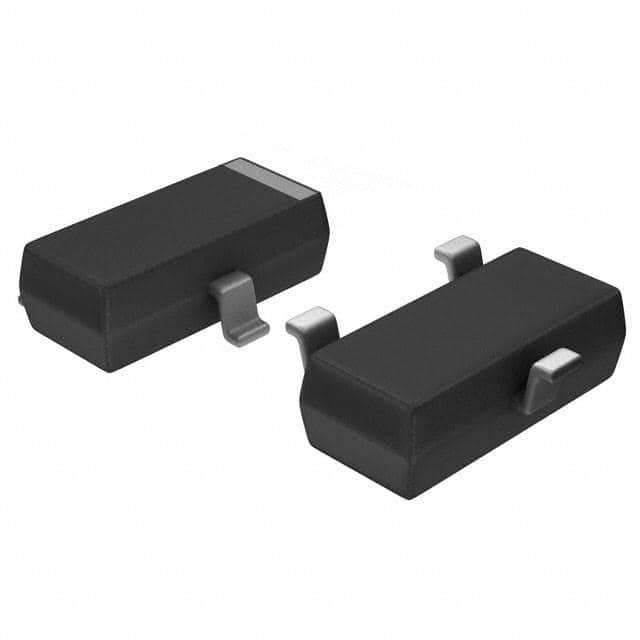BCW69 Transistor: An Overview
Introduction
The BCW69 is a general-purpose NPN bipolar junction transistor (BJT) commonly used in electronic circuits for amplification and switching purposes. This entry provides an in-depth overview of the BCW69, including its product details, specifications, pin configuration, functional features, advantages and disadvantages, working principles, application field plans, and alternative models.
Product Information Overview
- Category: Bipolar Junction Transistor (BJT)
- Use: Amplification and Switching
- Characteristics: High current gain, low noise, and low power dissipation
- Package: SOT-23
- Essence: Small-signal transistor
- Packaging/Quantity: Typically available in reels or tubes containing multiple units
Specifications
- Maximum Collector-Base Voltage (Vcbo): 45V
- Maximum Collector-Emitter Voltage (Vceo): 45V
- Maximum Emitter-Base Voltage (Vebo): 6V
- Continuous Collector Current (Ic): 100mA
- Power Dissipation (Pd): 250mW
- Transition Frequency (ft): 250MHz
Detailed Pin Configuration
The BCW69 transistor typically consists of three pins: 1. Collector (C): Connected to the positive supply voltage in most applications. 2. Base (B): Controls the transistor's conductivity when a small current is applied. 3. Emitter (E): Connected to the ground in most applications.
Functional Features
- High current gain allows for efficient signal amplification.
- Low noise characteristics make it suitable for low-level signal processing.
- Low power dissipation enables energy-efficient operation.
Advantages and Disadvantages
Advantages
- High current gain for effective signal amplification.
- Low noise characteristics for high-fidelity signal processing.
- Compact SOT-23 package for space-constrained designs.
Disadvantages
- Limited maximum collector current compared to other transistors.
- Relatively low breakdown voltages compared to power transistors.
Working Principles
The BCW69 operates based on the principles of bipolar junction transistors, where the flow of current between the collector and emitter is controlled by the base current. By modulating the base current, the transistor can amplify or switch electronic signals.
Detailed Application Field Plans
The BCW69 transistor finds extensive use in various electronic applications, including: - Audio amplifiers - Signal processing circuits - Oscillator circuits - Switching circuits
Detailed and Complete Alternative Models
Some alternative models to the BCW69 include: - BCW68 - BCW70 - 2N3904 - 2N2222
In conclusion, the BCW69 transistor offers a balance of high current gain, low noise, and compact packaging, making it suitable for a wide range of amplification and switching applications in electronic circuits.
[Word Count: 366]
قم بإدراج 10 أسئلة وإجابات شائعة تتعلق بتطبيق BCW69 في الحلول التقنية
What is BCW69?
- BCW69 is a high-frequency, low-noise NPN bipolar junction transistor (BJT) designed for use in RF amplifiers and oscillators.
What are the key features of BCW69?
- BCW69 features low noise figure, high transition frequency, and high current gain, making it suitable for high-frequency applications.
What are the typical applications of BCW69?
- BCW69 is commonly used in RF amplifiers, oscillators, and other high-frequency signal processing applications.
What is the maximum operating frequency of BCW69?
- BCW69 has a maximum operating frequency of several gigahertz, making it suitable for high-frequency applications.
What is the recommended biasing configuration for BCW69?
- The recommended biasing configuration for BCW69 is typically common-emitter or common-base configuration, depending on the specific application requirements.
What are the thermal considerations for BCW69 in technical solutions?
- Thermal management is important for BCW69 to ensure proper heat dissipation, especially in high-power applications. Proper heatsinking and thermal design should be considered.
Are there any alternative transistors that can be used in place of BCW69?
- Yes, there are alternative transistors with similar characteristics that can be used as substitutes for BCW69, but it's important to carefully evaluate their performance and compatibility with the specific application.
What are the typical voltage and current ratings for BCW69?
- BCW69 typically operates at low to moderate voltage levels and handles relatively low to moderate currents, which are suitable for many RF applications.
How does BCW69 perform in low-noise amplifier (LNA) circuits?
- BCW69 is well-suited for use in LNA circuits due to its low noise figure and high current gain, which are essential for maintaining signal integrity in sensitive RF systems.
What are the packaging options available for BCW69?
- BCW69 is available in various surface-mount and through-hole packages, providing flexibility for different assembly and integration requirements in technical solutions.


